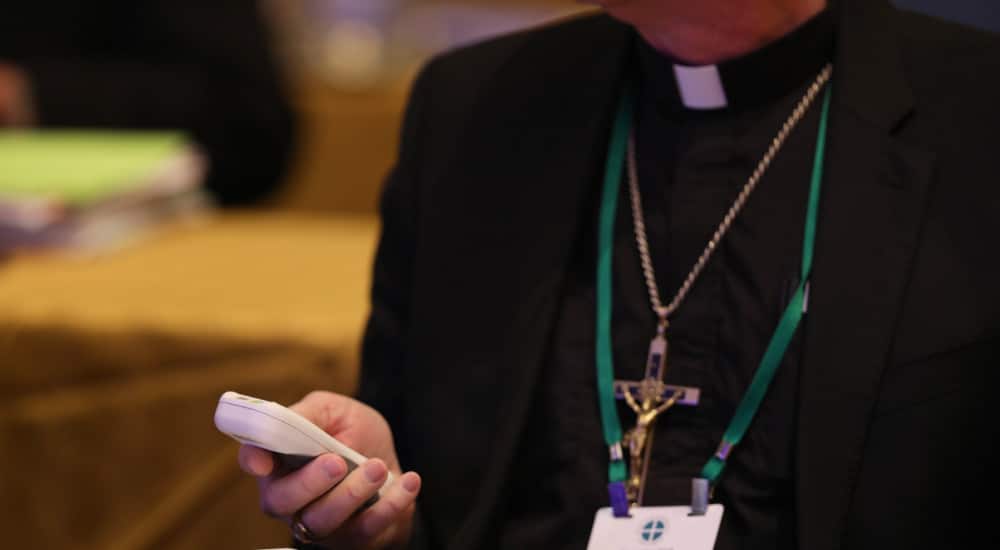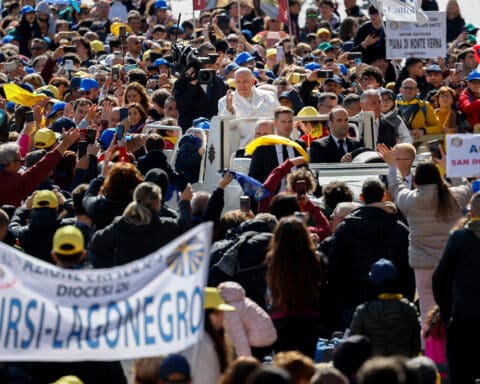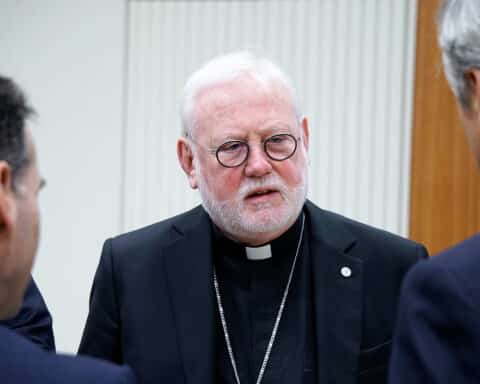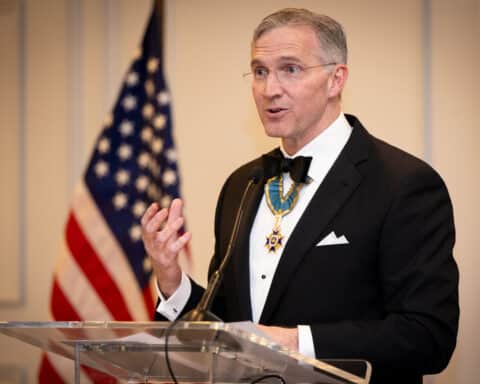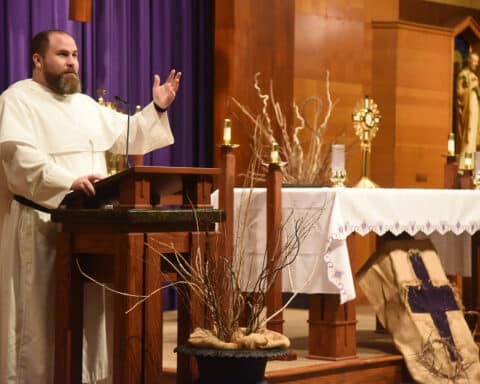When considering a name for our first-born, my wife and I confronted a dilemma: we loved the name Frederick, but we couldn’t think of a well-known saint whom we could reliably claim to be his name-patron (claiming the stupor mundi as inspiration seemed literally and figuratively verging on heresy). After a little internet sleuthing, I stumbled upon St. Frederick, a ninth-century bishop of Utrecht in what is now the Netherlands.
According to William of Malmsbury’s account, St. Frederick was stabbed to death by hired hitmen after celebrating Mass, martyred because of his frequent public denunciations of Carolingian Empress Judith’s extramarital affairs. Not exactly the stuff of children’s book hagiography, but he was a bishop, a martyr and a saint. St. Frederick of Utrecht would do.
It is, God willing, unlikely that the next president of the U.S. Conference of Catholic Bishops, who will be elected at the upcoming fall general assembly (Nov. 14-17), will face such violent opposition as St. Frederick. Nonetheless, whichever bishop is elected will face a daunting set of challenges that is well-known to readers. As the Barque of St. Peter sails into the growing swells of modern culture, I would like to pose two additional questions for discernment by the next president of the U.S. bishops’ conference, corresponding to two focuses of the Church today: lay leadership and participation in the Church, and the vital work of the Eucharist Revival.
What does lay participation really mean?
The Second Vatican Council’s affirmation of the “universal call to holiness” and its emphasis on greater participation of the laity in the life of the Church has encouraged a great outpouring of lay energy on behalf of the Church. The recent and ongoing Synod of Bishops on synodality has extended conversation on this important question.
For example, the recent working document of the synod asks: “Many groups would like to see greater participation of the laity, but the margins for maneuver are unclear: What concrete tasks can the laity perform? How is the responsibility of the baptized articulated with that of the parish priest?” The document continues: “When it enters into the concrete life of the Church, the theme of ministeriality inevitably meets with the question of its institutionalization. This raises the question of the structures through which the life of the Christian community unfolds.”
| Follow along |
|---|
|
You can watch the livestream of the USCCB’s general assembly, from Nov. 14-17, by visiting: https://www.usccb.org/. |
One the one hand, these are reasonable questions and concerns. The daily activity of the “institutional” Church consists in the work of priests and bishops — the administration of sacraments, the management of Church finances, property and social services, and the pastoral work of leading the flock. Where does the laity reasonably fit into these activities?
At the same time, these questions miss a substantial part of how the laity conceive of their roles within the Church, particularly in America, where the laity are already busy starting and growing Catholic organizations that are advancing the fundamental work of the Church to proclaim the Gospel of Christ to the world.
In well-intentioned deliberations and initiatives, Church leaders may default to an assumption that lay participation in the Church means lay involvement in formal ecclesial structures, hierarchies and ministries emanating from parishes and chanceries. And while I have known a good many laypersons who contribute their enormous gifts of faith and leadership to the Church in this way — serving on parish councils, leading religious education, volunteering in any number of capacities — many dynamic laypeople participate in and lead Catholic organizations that exist outside of the ecclesial structures of the Church.
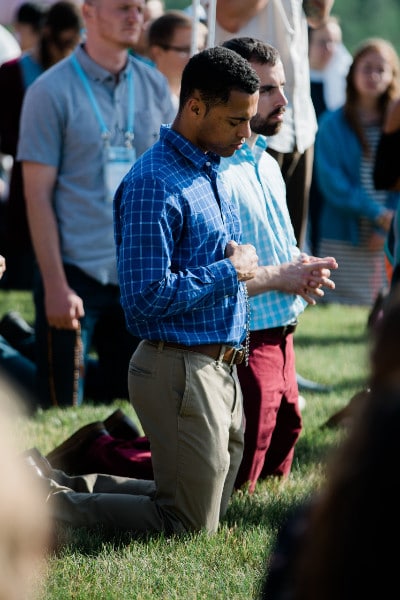
Catholic evangelical organizations such as FOCUS; academic institutes such as the Lumen Christi Institute, the Collegium Institute, the de Nicola Center for Ethics and Culture, the McGrath Institute for Church Life, and the Portsmouth Institute for Faith and Culture (which I direct as an apostolate of two Benedictine abbeys and their affiliated school); classical Catholic schools, often founded, staffed and led by laypeople; lay Catholic teachers and campus ministers working in parish or diocesan schools; professors teaching and researching at Catholic and secular universities; lay-led Catholic colleges like the University of Dallas, Wyoming Catholic College, Thomas Aquinas College, Thomas More College, Magdalen College and Christendom College; lay board members of Catholic schools and colleges; benefactors supporting Catholic organizations and charities; lay-led Catholic publishing houses like Ignatius Press, Cluny Media and OSV; magazines from Commonweal to the Catholic Herald to The Lamp staffed and led by the laity; Catholic authors and journalists; even dynamic ministries led by Catholic priests and prelates, such as Word on Fire and the Thomistic Institute, which heavily rely on lay staff and donor leadership; and last but certainly not least, moms and dads raising their children in the Faith: all of these and many more are examples of existing lay leadership and participation in the Church.
Rather than asking, therefore, how to encourage the laity to participate in the life of the Church, the next president of the USCCB might ask instead: How can the episcopal structures of the Church support, encourage, collaborate with and rely upon these lay-led Catholic institutions, which are already part of the life and leadership of the Church?
How can the Church encourage a Eucharistic imagination among the young?
One time while on vacation, I attended Mass at a parish in Hanover, New Hampshire, with my wife and two young kids. While the priest consecrated the Eucharist and drank from the chalice, one of my sons, who was 4 at the time, whispered in a mixture of shock and fascination, “He’s drinking the blood!”
The National Eucharistic Revival is one of the most exciting initiatives in the Church today, precisely because it reflects an enormous opportunity to invite all people — practicing Catholics, ex-Catholics, non-Catholics — deeper into the Catholic faith and to encounters perhaps not wholly dissimilar from what my son experienced during that Mass. The announcement by Archbishop José H. Gomez of Los Angeles, the outgoing president of the bishops’ conference, at the start of the Eucharistic Revival beautifully captures the aim of the movement to “restore the vision of the Eucharist to the heart of Catholic identity and to our experience as followers of Jesus Christ.”
No doubt the Eucharistic Revival includes an emphasis on confidently proclaiming the truth of the Eucharist not only to non-Catholics but to Catholics who frequently don’t know what the Church teaches about the Real Presence. Anecdotally, this focus is already working: A family member of mine has renewed and grown in her Catholic faith because of Bishop Robert Barron’s teaching on the Eucharist through his Word on Fire ministry.
And while clear teaching on the Eucharist is very much needed, so, too, are deep and meaningful experiences of the “mystery of the Eucharist,” as Archbishop Gomez wrote.
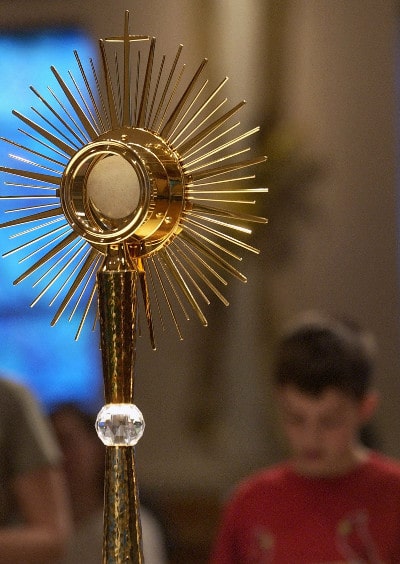
This is especially needed among the young — children my young kids’ ages, but also up to the ages of the high school students I teach. As engrossing as TikTok and Instagram may be, the young people I know use it with some sense of irony. They know it’s trivial and silly and that they waste too much of their time using it, yet there are too few meaningful experiences to otherwise grasp their attention. On the contrary, one of the most moving experiences of my adult life was witnessing Eucharistic adoration at a FOCUS SEEK conference, where over 10,000 teenagers and young adults knelt in quiet and humble reverence before the Eucharist.
The mystery of the Eucharist is precisely the kind of transcendent experience our young people are longing for — and not just to be taught the logic of transubstantiation (however important that may be) but to be invited into the awe and majesty and sacredness that the Eucharist in itself is, through Eucharistic devotions and reverent celebrations of the liturgy.
And so, as the Church continues its National Eucharistic Revival and considers initiatives to recenter the Eucharist in the life of the faithful, what can the Church do to facilitate these deep, meaningful and mysterious experiences of the Eucharist for young people? Whether through opportunities for Eucharistic adoration in parishes and schools, clear and confident teaching on the Eucharist, pilgrimages to sites associated with the Eucharist, stories of saints transformed by the Eucharist and stories of Eucharistic miracles, we have such a rich treasure of Eucharistic life to invite young people to experience.
And, despite the challenges facing the Church today, the Eucharistic Revival represents an exciting opportunity to witness to the richness of the Faith — one that the incoming president of the USCCB, whoever it will be, will do yeoman’s work to harness.
Christopher Fisher is the executive director of the Portsmouth Institute for Faith and Culture and a teacher in the Department of Humanities at Portsmouth Abbey School, a Catholic, Benedictine boarding school in Rhode Island.

